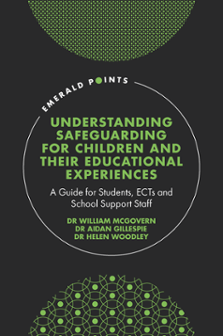
Safeguarding, Vulnerability, Family Functioning
Understanding Safeguarding for Children and Their Educational Experiences
ISBN: 978-1-80262-710-7, eISBN: 978-1-80262-709-1
Publication date: 17 June 2022
Citation
(2022), "Safeguarding, Vulnerability, Family Functioning", McGovern, W., Gillespie, A. and Woodley, H. (Ed.) Understanding Safeguarding for Children and Their Educational Experiences, Emerald Publishing Limited, Leeds, pp. 1-1. https://doi.org/10.1108/978-1-80262-709-120221018
Publisher
:Emerald Publishing Limited
Copyright © 2022 William McGovern, Aidan Gillespie and Helen Woodley. Published under exclusive licence by Emerald Publishing Limited
Understanding Concepts of Vulnerability; in this opening section we will introduce, explore and contextualise how concepts such as social, economic, familial and individual vulnerability are understood. Illustrative topics which will be covered will be focussed on contextual safeguarding, perceptions and definitions of vulnerability and how these might be encountered and supported within the education setting and wider education practice. Specific reference will be made in this section to explore how perceptions of vulnerability inform practice and the ways in which vulnerability concerns are believed to adversely affect children's education and wellbeing, then their learning and development. One of the key focusses within this opening section relates to identifying the dangers associated with assuming a particular type of harm or the lack of harm can be associated with a particular type of vulnerability, family structure and/or family functioning.
- Prelims
- Section One Safeguarding, Vulnerability, Family Functioning
- 1 Why Schools, Why Now and Why Safeguarding
- 2 Schools and Safeguarding: Thinking Through Spaces and Contexts of Vulnerability and Harm
- 3 Vulnerability or Vulnerabilities: Contestation of Applied Markers of Identity
- 4 Vulnerability – Labels and Labelling
- 5 Understanding Need and Challenging Perceptions of Family Functioning in Relation to Parental Substance Use and Misuse
- Section Two Enhancing Pupil Engagement and Teaching Practice
- 6 Complex and Hidden Lives
- 7 Nobody Is ‘Special’: The Application of a Community of Practice to Arrive at Being ‘Ordinary’ Within the Classroom: A Model of Diversity
- 8 Teacher Agency and Negative Labelling
- 9 A Manifesto for Attuned Teaching
- 10 Not So Textbook: Understanding the School Experiences of Young Carers
- Section Three Understanding the Nature of Concerns and Risk
- 11 Understanding How Perceptions of Children Shape Perceptions of Risk and Needs in Relation to Safeguarding Concerns in Schools
- 12 Just a Bottle in the Park: Alcohol Use in Vulnerable Children
- 13 Illicit Substance Use, Poly Use, Game Playing and Increased Vulnerability
- 14 County Lines
- 15 Food Insecurity in School-Aged Children
- Index